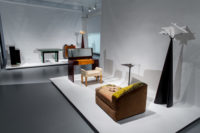Diller Scofidio + Renfro Design 'Heavenly Bodies' at the Met

Items from the Catholic-themed show are set within existing exhibitions, and span a variety of spaces in the Cloisters and upper- and lower-level galleries within the Met’s Fifth Avenue building.
Photo © Floto + Warner

Items from the Catholic-themed show are set within existing exhibitions, and span a variety of spaces in the Cloisters and upper- and lower-level galleries within the Met’s Fifth Avenue building.
Photo © Floto + Warner

Items from the Catholic-themed show are set within existing exhibitions, and span a variety of spaces in the Cloisters and upper- and lower-level galleries within the Met’s Fifth Avenue building.
Photo © Floto + Warner

Items from the Catholic-themed show are set within existing exhibitions, and span a variety of spaces in the Cloisters and upper- and lower-level galleries within the Met’s Fifth Avenue building.
Photo © Floto + Warner




Architects & Firms
You might say it took a small miracle to pull off this exhibition. Heavenly Bodies: Fashion and the Catholic Imagination, on display until October 8, spans 27 galleries and two locations—New York’s Metropolitan Museum of Art’s main building on Fifth Avenue and its annex, the Cloisters, in upper Manhattan—and includes 40 masterworks of papal regalia from the Sistine Chapel sacristy (the first Vatican loan to the Met in 35 years). Then there’s the fashion—contemporary pieces inspired by Catholic themes and imagery, by the houses of Thierry Mugler, Jean Paul Gaultier, Yves Saint Laurent, Dolce & Gabbana, Chanel, Rodarte, and Versace, among others.
The result is a mix of elaborate confections and pious ensembles interspersed with religious art and artifacts from the Met’s collection, in an array of spaces ranging from long, brightly lit galleries to low crypts. Unifying the display, from the pageantry on Fifth Avenue to the austerity and sanctity farther uptown, is the discreet exhibition design by Diller Scofidio + Renfro (DS+R).
The Met’s Costume Institute had previously tapped the interdisciplinary firm for an exhibition of couturier Charles James’s work in 2014. While that design utilized a variety of digital media, the design for Heavenly Bodies is as minimal as could be. “This was a different calling,” jokes DS+R partner Elizabeth Diller.
DS+R’s role this time around was that of mediator, explains Diller, playing off the axiality and symmetry of the spaces, but also reflecting diverse attitudes, whether ironic, critical, or reverent. Legibility of the installed costumes and baubles as new—especially within the context of already highly curated galleries, featuring objets d’art that often could not be moved—was paramount. To effect a consistent language throughout the sprawling show, DS+R limited the display hardware. While pedestals range in size, proportion, and height—some dramatically propping up a succession of mannequins overhead—each is composed of cruciform-shaped blackened steel atop a concrete base, injecting a soupçon of Carlo Scarpa’s intervention in the Castelvecchio in Verona. Some, like those displaying the jeweled tiaras and intricately embroidered cassocks belonging to former popes, are encased in glass or acrylic.
According to the exhibition’s curator, Andrew Bolton, the works on display “embody the storytelling tradition of the Catholic church.” The enchanted world they create is worthy of the pilgrimage.








